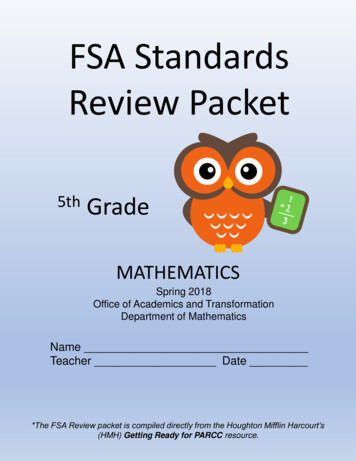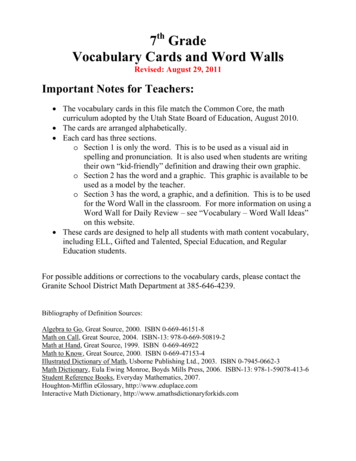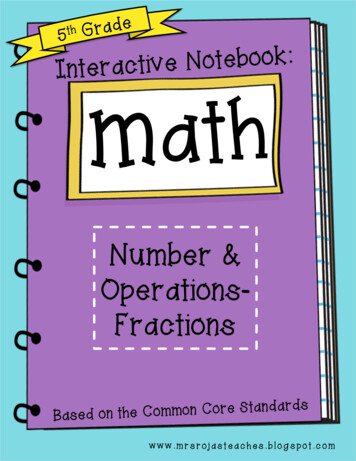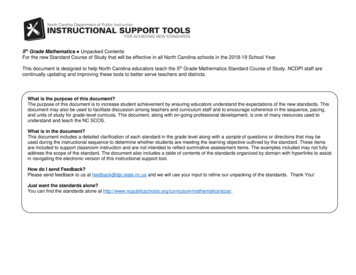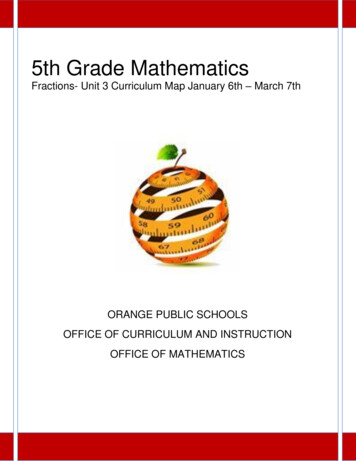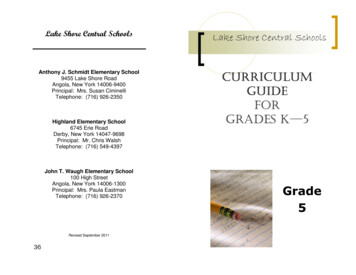
Transcription
Lake Shore Central SchoolsAnthony J. Schmidt Elementary School9455 Lake Shore RoadAngola, New York 14006-9400Principal: Mrs. Susan CiminelliTelephone: (716) 926-2350Highland Elementary School6745 Erie RoadDerby, New York 14047-9698Principal: Mr. Chris WalshTelephone: (716) 549-4397John T. Waugh Elementary School100 High StreetAngola, New York 14006-1300Principal: Mrs. Paula EastmanTelephone: (716) 926-2370Revised September 201136Lake Shore Central SchoolsCURRICULUMGUIDEFORGRADES K—5Grade5
A MESSAGE FROM THESUPERINTENDENTNOTESDear Parent/Guardian,As you are aware, New York State has adopted aseries of initiatives which have established Common Core StateStandards for grades K-5. Within a series of booklets, LakeShore Central Schools will provide an overview of the Common Core State Standards, district initiatives in achievingthose standards, and core curriculums in English LanguageArts, Mathematics, Science and Social Studies. In addition,these booklets provide the goals and objectives for each gradelevel in the various subjects. It is our hope this information willprovide an opportunity for each of you to assist in the learningprocess of our children.The education of our children is the responsibility ofeveryone—the district, parents and the students themselves. Inorder to achieve success, everyone must work together in thisimportant process. I encourage each of you to take an activerole in the education of our children to ensure they achieve theirfull potential.I look forward to working with you as we embark uponnew and exciting times in the education of our children at LakeShore Central Schools.Sincerely,James PrzepasniakSuperintendent of Schools235
K-5 WEBSITESFor additional information about our curriculum, see theWebsite for the Lake Shore Central School District.Curriculum information will be found under the heading ofInstructional Programs.Lake Shore Central Schoolhttp://www.lakeshorecsd.orgCONTENTSA MESSAGE FROM THE SUPERINTENDENTHOMEWORK POLICY24-5COMMON CORE STATE STANDARDSENGLISH LANGUAGE ARTSMATHEMATICS, SCIENCE & TECHNOLOGYMATHEMATICAL MST #3SOCIAL STUDIES61516-1724GRADE LEVEL CURRICULUM DESCRIPTORS & OBJECTIVESFor additional information about specific topics, please visit thefollowing web sites:New York State Education Department Parent INGLISTENINGSPEAKINGMATHEMATICSSCIENCESOCIAL STUDIESOffice of State Assessment7-913141418-2021-2325-31NYS TESTINGhttp://www.p12.nysed.gov/apda/Office of Curriculum and Instructional Supporthttp://www.p12.nysed.gov/ciai/ENGLISH LANGUAGE ARTSMATHEMATICSELEMENTARY SCIENCESOCIAL STUDIES33333333SUGGESTIONS FOR PARENTSCommon Core State Standards EMATICSSOCIAL STUDIESRECOMMENDED READING LISTEducation is a social process Education is growth Education is not a preparation for life;Education is life itself.—-John Dewey3412202610-11DEVELOPMENTAL DESCRIPTIONS32K-6 CURRICULUM WEBSITES343
HOMEWORKPOLICYPhilosophy:Homework is a valuable aid in helping studentsmaximize their school experience. It reinforces classroomlearning, builds responsibility, and develops essentialstudy habits. Homework is one vehicle for home-schoolcommunication. Parents are encouraged to make it apositive experience for children. Parents must plan ahomework time in order to strike a balance betweenacademics, family life and the child’s needs.General Types of Homework: Practice assignments reinforce skills and conceptstaught in class. Preparation assignments provide background information before topics appear in class. Extension assignments emphasize individual needsand interests, creativity and application of knowledgegained in class. Study assignments prepare students for tests andprovide the completion of independent reading.Student Responsibilities:Responsibilities1. Listen to class directions for assignments and includedue date if necessary.2. Ask questions if you do not understand theassignment.3. Take home the instructions and materials needed tocomplete the assignment.4. Work with your parents to set a regular time and placeto do your homework.5. Do your own work, but ask your parents for assistanceif needed.6. Work should be complete, legible and done to thebest of your ability.7. Show your parents the completed work to ensurequality.8. Ask your teacher for help the next day if you did notunderstand the assignment.9. Return assignments on the date due.4N.Y.S. TESTINGEnglish Language Arts (ELA)3rd, 4th, 5th, 6th, 7th & 8th GradeMathematics3rd, 4th, 5th, 6th, 7th & 8th GradeScience4th & 8th GradeSocial Studies5th & 8th Grade33
FIFTH GRADEHOMEWORKPOLICYDEVELOPMENTAL DESCRIPTORSBelow are some general developmental milestones to help youunderstand your child’s progress over the school year. Keep in mind thatevery child is different and may not fit perfectly into this framework.The Fifth Grader should. Tend to be obedient, good natured, and fun. Possess a surprising scope of interests. Be capable of increasing independence. Become more truthful and dependable. Tend to be improving his/her self-concept and acceptance of others. Form good personal relationships with teachers and counselors.School isn’t just academics. Your child’s teachers are also helping him/hergrow socially. At ten-years-old, your child is developing communication skillsand becoming more mature.The Fifth Graders should Improve their listening and responding skills. Increase their problem-solving abilities. Begin to undergo maturational changes. Gain awareness of peer and adult expectations.Signs of Trouble Failure to do their homework and gain the added practice will causestudents considerable difficulty in fifth grade. A poor understanding of the rules of grammar will be reflected insub-par writing. Difficulties in mathematics will be compounded for those students whohaven’t learned to solve word problems or mastered the basic facts(addition, subtraction, multiplication and division).The Fifth Graders may have trouble if they are not able to. Write solid sentences and paragraphs. Work in groups. Analyze and recall facts. Give talks and share the information they’ve learned. Read content area materials.32The following are guidelines for parents to help monitor theduration of homework assignments. The frequency and/or thenature of assignments may differ among teachers.GradeKGrade 1Grade 2Grade 3Grade 4Grade 5Approximate Time15 minutes (assisted)15 minutes15-20 minutes20-30 minutes30-45 minutes45-60 minutesParent Responsibilities:1. Provide a quiet and well-lit work area with neededhomework materials.2. Schedule a regular time for completion of homework.3. Insist that homework be completed and returned to schoolon its due date.4. Praise your child for his/her efforts. Display his/herpapers and artwork at home. Communicate a positiveschool attitude.5. Assist your child with assignments only if necessary. Donot over-supervise.6. Consult your child’s teacher when necessary.7. Enhance your child’s learning through enriching andrelated experiences such as trips to the library and familyfield trips.8. Read for pleasure with your child.5
FIFTH GRADEENGLISH LANGUAGEARTS (ELA)New York State English Language Arts StandardsStandard 1: Language for Information and UnderstandingStudents will listen, speak, read, and write forinformation and understanding. As listeners andreaders, students will collect data, facts, andideas; discover relationships, concepts, andgeneralizations; and use knowledge generatedfrom oral, written, and electronically producedtexts. As speakers and writers, they will use oraland written language that follows the acceptedconventions of the English language to acquire,interpret, apply and transmit information.Standard 2: Language for Literacy Response and ExpressionStudents will read and listen to oral, written andelectronically produced texts and performancesfrom American and World literature; relate textand performances to their own lives; and developan understanding of the diverse social, historical,and cultural dimensions the texts andperformances represent. As speakers and writers,students will use oral and written language thatfollows the accepted conventions of the Englishlanguage for self-expression and artistic creation.Standard 3: Language for Critical Analysis and EvaluationStudents will listen, speak, read and write forcritical analysis and evaluation. As listeners andreaders, students will analyze experiences, ideas,information and issues presented by others, usinga variety of established criteria. As speakers andwriters they will use oral and written language thatfollows the accepted conventions of the Englishlanguage to present, from a variety ofperspectives, their opinions and judgments onexperiences, ideas, information and issues.Standard 4:6Language for Social InteractionStudents will listen, speak, read and write forsocial interaction. Students will use oral andwritten language that follows the acceptedconventions of the English language for effectivesocial communication with a wide variety ofpeople . As readers and listeners, they will usethe social communication of others to enrich theirunderstanding of people and their views.SOCIAL STUDIESTHE STUDENTS WILL BE ABLE TO . Understand constitutions, rules and laws are developed indemocratic societies in order to maintain order, provide security,and protect individual rights.Recognize that the rights of citizens in the United States are similarto and different from the rights of citizens in other nations of theWestern Hemisphere.Recognize that the roles of citizenship are defined by differentconstitutions in the Western Hemisphere.Identify that governmental structures vary from place to place, asdo the structure and functions of governments in the United States,Canada, and Latin American countries today.Understand concepts, such as civic life, political, and governmentthat can be used to answer questions about what governments canand should do, how people should live their lives together, and howcitizens can support the proper use of authority or combat theabuse of political power.Recognize legal, political, and historical documents that define thevalues, beliefs, and principles of constitutional democracy. In theUnited States these documents include the Declaration ofIndependence, the United States Constitution, and the Bill ofRights. In Canada these documents include the British NorthAmerica Act and Canadian Bill of Rights.Understand that citizenship in the United States, Canada, andnations of Latin America include an awareness of the patrioticcelebrations of those nations. In the United States thesecelebrations include: Lincoln’s Birthday, Washington’s Birthday,Independence Day, Dr. Martin Luther King, Jr. Day, ThanksgivingDay, Election Day, Flag Day, Memorial Day, and Conservation Day.Recognize that international organizations were formed to promotepeace, economic development, and cultural understanding. TheUnited Nations was created to prevent war and to fight hunger,disease, and ignorance.31
FIFTH GRADEFIFTH GRADESOCIAL STUDIESELA DESCRIPTORSTHE STUDENTS WILL BE ABLE TO .READINGWill recognize that individuals and groups in the United States,Canada, and Latin America attempt to satisfy their basic needsand wants by utilizing scarce capital, natural and humanresources. Evaluate types and availability of resources that are important toeconomic development in the United States, Canada, and LatinAmerica today. Understand the interdependence of nations North, Central andSouth America which depends on one another for variousresources and products they need. Understand that the production, distribution, exchange, andconsumption of goods and services are economic decisionswhich the nations of North and South America must make. Recognize that science and technology have influenced theand cultural dimensions the texts andstandard of living in nations in North, Central and SouthAmerica. Recognize that exchanges of technologies, plants, animals, anddiseases between and among nations of the Americas andEurope and sub-Saharan Africa have changed life in theseregions. Recognize that as the economic systems of the globalcommunity have become more interdependent, decisions madein one nation or region in the Western Hemisphere haveimplications for all nations or regions.The Governments of the United States, Canada, and LatinAmerican nations. Draw conclusions that across time and place, the people of theWestern Hemisphere have held differing assumptions regardingpower, authority, governance, and law. Categorize basic civic values, such as justice, due process,equality, and majority rule with respect for minority rights areexpressed in the constitutions and laws of the United States,Canada, and Latin America. 30THE STUDENT:Students in fifth grade are confident, independentand enthusiastic readers. Background knowledge and higherlevel thinking skills allow them to appreciate a variety ofliterature, including novels, poetry, and reference materials.They have internalized reading strategies and demonstratefluent oral expression. The ability to analyze and interprettext is developing. They successfully connect ideas in text toother ideas, experiences, and literature.THE PROGRAM:Through the implementation of the literature-basedreading program, the process approach to the teaching ofwriting, experiences in preparation, engagement, andresponse, Lake Shore students will become competentreaders, writers, listeners and speakers.A balanced literacy approach builds a connectionbetween reading and writing. Reading includes: phonemicawareness, phonics, fluency, vocabulary, and comprehension. Writing is taught using a process approach whichemphasizes content, as well as mechanics and spelling.Experiences in the ELA program will help students to listenfor and retain information, as well as to speak clearly andconfidently in large and small group setting.7
FIFTH GRADEFIFTH GRADEELA-READING OBJECTIVESSOCIAL STUDIESThe Fifth Grader will be able to . Skim and scan text to determine if a book or passagehas information needed. Use charts and graphs to interpret text. Use schedules to understand information. Draw conclusions and make inferences frominformation. Evaluate information in text. Use the compare and contrast strategy to collectinformation from various sources. Draw conclusions and make inferences about newmaterial, as it relates to experiences. Read stories from a variety of genres to identify plot,character and setting. Use the card and electronic catalog to search for abook by title, author or subject. Use encyclopedia to locate and gather information. Choose reference sources, such as thesaurus,dictonary, telephone directory, atlas, encyclopedia andalmanac for information and appropriate searchengines on internet. Read a story and identify how characters change withinthe plot. Read about problem solving and decision-making tohave the information needed to compare characters inthe story to people in their lives. Read a story to identify and recognize literary devices,such as simile, metaphor, and personification in orderto create and gain meaning from text.8THE STUDENTS WILL BE ABLE TO .Geography of the United States, Canada, and Latin America Use maps and other geographic representations, tools, andtechnologies, such as aerial and other photographs, satelliteproduced images, and computer models to gather, process,and report information about the United States, Canada, andLatin America today. Recognize that political boundaries change over time andplace. Identify different geological processes which shaped thephysical environments of the United States, Canada, and LatinAmerica. Categorize nations and regions of the Western Hemisphere interms of spatial organization, places, regions, physical settings(including natural resources), human systems, andenvironment and society. A region is an area that is tiedtogether for some identifiable reason, such as physical,political, economic or cultural features. Draw inferences from the physical and human characteristicsof places in the United States, Canada, and Latin Americatoday. Explain the characteristics, distribution, and complexity ofcultures found in the United States, Canada, and LatinAmerica. Understanding human actions can modify the physicalenvironments of the United States, Canada, and LatinAmerica.The Economies of the United States, Canada, and LatinAmerica Understand how concepts, such as scarcity, supply anddemand, markets, opportunity costs, resources, productivity,economic growth, and systems can be used to study theeconomies and economic systems of the United States,Canada, and Latin America.29
New York State recommendsFIFTH GRADEthat students read a minimumSOCIAL STUDIESof 25 books per year acrossTHE STUDENTS WILL BE ABLE TO .all content areas and standards.History of the United States, Canada, and Latin America Demonstrate an understanding of different ethnic,national, and religious groups, including Native AmericanIndians, and how they have contributed to the culturaldiversity of these nations and regions by sharing theircustoms, traditions, beliefs, ideas, and languages.Recognize that different people living in the Westernhemisphere view the same event or issues from differentperspectives. Demonstrate an understanding of the migration of groupsof people in the United States, Canada, and Latin Americathat has led to cultural diffusion because people carry theirideas and ways of life with them when they move fromplace to place. Identify connections and exchanges that exist betweenand among the people of Europe, sub-Sahara Africa,Canada, Latin America, the Caribbean, and the UnitedStates. These connections and exchanges includesocial/cultural, migration/immigration, and scientific/technological. Identify and organize key turning points and events in thehistories of Canada, Latin America, and the United Statesinto different historical time periods. For example, keyturning points might include: 18th-century exploration andencounter; 19th-century westward migration andexpansion, 20th-century population movement from ruralto suburban areas. Recognize that important historic figures and groups havemade significant contributions to the development ofCanada, Latin America, and the United States. Demonstrate an understanding of industrial growth anddevelopment and urbanization have had important impactson Canada, Latin America, and the United States.The students read for: Information and understanding Literary response and expression Critical analysis and evaluation Social interactionThe following recommended reading list is asampling of the typical books that may be selected forthis grade level.Children, with support from teachers andparents, are expected to read 25 age-appropriatebooks.The selections address many interests andmaturity levels.When selecting a book, attentionshould be given to personal preference and needs.Students should use many strategies whilereading.They should systematically monitor theirpersonal reading by asking themselves questions suchas “Does it sound right?”, “Does it make sense?” and“Does it look right?” The primary goal should alwaysbe to read for understanding and enjoyment.The single most important activity for building theknowledge required for success in readingis reading.Jim Trelease289
SOCIAL STUDIESK-5FIFTH GRADERECOMMENDED READING LIST(WITH AUTHOR’S LAST NAME)George, Jean Craighead—ALL TITLESDahl, Roald—ALL TITLESSacher, Louis—ALL TITLESMacLachlan, Patricia—ALL TITLESChristopher, Matt—ALL TITLESHite, Sid—MY NAME IS AMERICA SERIESGregory, Kristiana—THE ROYAL DIARIES SERIESGantos, Jack—JOEY PIGZA BOOKSGardiner, John Reynolds—STONE FOXLevine, Gail Carson—ELLA ENCHANTEDRyan, Pam Munoz—RIDING FREEDOMNaylor, Phyllis Reynolds—SHILOHCreech, Sharon—LOVE THAT DOGClements, Andrew—FRINDLEEstes, Eleanor—THE HUNDRED DRESSESFleischman, Sid—THE WHIPPING BOYDeCamillo, Kate—THE TALE OF DESPERAUXBlume, Judy—BLUBBERSpinelli, Jerry—MANIAC MAGEECurtis, Christopher Paul—BUD, NOT BUDDYGiff, Pattricia Reilly— PICTURES OF HOLLIS WOODSHiaason, Carl—HOOT10Grade Five: The United States, Canada, and Latin AmericaThe grade 5 social studies program stresses geographic,economic, and social/cultural understandings related to theUnited States, Canada, and nations in Latin America today.These perspectives build on and reinforce historic and politicalcontent about the United States included in the grade 4 socialstudies program. When appropriate, the grade 5 programshould use contemporary examples of case studies to helpstudents understand the content understandings that follow.The content understandings were developed to assist inselecting specific factual information and case studies.Content Understandings History of United States and Canada. Geography of United States, Canada and Latin America. The economies of United States, Canada and LatinAmerican nations. The governments of United States, Canada and LatinAmerican nations.27
SOCIAL STUDIESK-5FIFTH GRADERECOMMENDED READING LIST(WITH AUTHOR’S LAST NAME)SKILLS K-5 Getting informed Using information Presenting information Participating in Interpersonal and Group RelationsPROBLEM SOLVING SKILLS K-5 The student will be able to define or identify a problem. The student will be able to hypothesize, investigate data and solveproblems which are either presented by the teacher or which areidentified by the student. The student will be able to work with others engaged inproblem-finding/solving skills and recognize and accommodatevalue conflicts in the decision making process. The student will be able to communicate orally, visually, and/or inwriting the results of the problem finding/solving effort.CONCEPTS ces and RegionCivic ValuesCultureEnvironmentInterdependenceNeeds and WantsTechnologyHannigan, Katherine—IDA B.AND HER PLANS Grodin, Elissa—D IS FOR DEMOCRACYStruass, Rochelle—TREE OF LIFECheney, Lynne—WHEN WASHINGTON CROSSEDTHE DELAWAREO’Dell, Scott—ISLAND OF THE BLUE DOLPHINSCleary, Beverly—DEAR MR. HENSHAWSpeare, Elizabeth George—THE SIGN OFTHE BEAVERCushman, Karen—CATHERINE CALLED BIRDYHollyer, Beatrice—LET’S EAT! WHAT CHILDRENEAT AROUND THE WORLDRumford, James—SEQUOYAH: THE CHEROKEEMAN WHO GAVE HIS PEOPLE WRITINGBurnett, Frances Hodgson—SECRET GARDENWright, Betty Ren—THE DOLLHOUSE MURDERSRuckman, Ivy—NIGHT OF THE TWISTERSSUGGESTIONS FOR PARENTS Make a family tree and talk about family history. Visit in your local community. Talk to your child at his/her level of understanding about worldevents. Read stories together about famous people. Talk about the history of the holidays: Fourth of July, Veterans Day,Patriots Day etc.2611
ELA—READINGSUGGESTIONS FOR PARENTSSOCIAL STUDIESK-5Making Reading a Family AffairHints For ParentsIn addition to daily homework assignments, besure to set aside some time each night for reading. Abook may be read in one evening or over a period ofseveral weeks.Ask your children to read aloud a portion of thebook that they like best. Praise them for trying anddoing a good job. This will help with their selfconfidence in order to build comprehension andpersonalize their understanding by asking them whatthey enjoyed about what they read. Encourage them todescribe the best part of the story.Give children an opportunity to make use of thelocal library. Help them find the appropriate section fortheir reading level. Teach older children to use thecard catalog (or computer) to locate books. Check outlibrary books on a regular basis.Remember to set an example for your children.Take time to read every day. When children see theirparents reading for pleasure, they are motivated to dothe same. Share what you have read with yourchildren.Reading can open doors to knowledge. It leadsto a world of information, adventure, mystery, laughterand love. Children will seek to enter this world withencouragement from home and school.Happy Reading!12In Social Studies, students confront questions aboutthe wonder and excitement of human kind in the world.Social Studies help students understand their roots, seetheir connections to the past, comprehend their context,recognize the commonality of people across time, appreciatethe delicate balance of rights and responsibilities in anopen society, and develop the habits of thoughtfulanalysis and reflective thinking. In helping students answerthese questions, social studies engage students in the studyof history, geography, economics, government and civics.Instruction draws on other disciplines such as anthropology,sociology, political science, psychology, religion, law,archaeology, philosophy, art, literature, other humanitiessubjects and the sciences.Social studies gives students the knowledge,intellectual skills, civic understanding, and dispositionstowards democratic values that are necessary to functioneffectively in American society. Ultimately, social studiesinstruction helps students assume their role as responsiblecitizens in America’s constitutional democracy and asactive contributors to a society that is increasinglydiverse and interdependent with other nations of the world.Social studies instruction provides students with the background to conduct research in order to cast informed votes,with the skills to place conflicting ideas in context, and withthe wisdom to make good judgments in dealing with thetensions inherent in society such as the enduring struggleto find the balance between protecting the rights of theindividual and promoting the common ground.25
SOCIAL STUDIESK-5Standard 1: History of the United States and New YorkStudents will use a variety of intellectual skills to demonstratetheir understanding of major ideas, eras, themes,developments, and turning points in the history of the UnitedStates and New York.Standard 2: World HistoryStudents will use a variety of intellectual skills to demonstratetheir understanding of major ideas, eras, themes, developments, and turning points in world history and examinethe broad sweep of history from a variety of perspectives.Standard 3: GeographyStudents will use a variety of intellectual skills to demonstratetheir understanding of the geography of the interdependentworld in which we live—local, national, and global— includingthe distribution of people, places, and environments over theEarth’s surface.Standard 4: EconomicsStudents will use a variety of intellectual skills todemonstrate their understanding of how the United Statesand other societies develop economic systems andassociated institutions to allocate scarce resources, howmajor decision-making units function in the United Statesand other national economies, and how an economy solvesthe scarcity problem through market and non-marketmechanisms.Standard 5: Civics, Citizenship, and GovernmentStudents will use a variety of intellectual skills to demonstratetheir understanding of the necessity for establishedgovernments; the governmental system of the United Statesand other nations; the United States Constitution; the basiccivil values of American constitutional democracy; and theroles, rights, and responsibilities of citizenship, includesavenues of participation.24FIFTH GRADEELA-WRITING DESCRIPTORSNew York State suggests that studentswrite 1000 words per month.Fifth grade students are writing to presentideas fully and clearly. They build anengaging plot around a situation, conflictor problem. They effectively present pointof view, sense of context, and/or characters. Their ideas arepresented in clear order and logical sequence with transitions madethrough the use of paragraphing, introductions, and/or conclusions.They demonstrate control of simple language conventions. Complexlanguage conventions are increasingly evident. They effectively usestrategies in their writing, such as dialogue, description, or suspenseto sustain the reader’s interest. This writer engages the reader withlively, descriptive language, a sense of audience, and an expressive,individual sense of voice.The Fifth Grader will be able to . Take notes from informational text in an organized manner. Paraphrase text to take notes and write reports. Write, compare and contrast paragraphs using several sources. Write a personal essay in paragraph form. Write a descriptive essay in paragraph form. Write a book report in paragraph form. Write research reports in paragraph form stating the main ideaand using supporting details. Write a poem with a lead that attracts the reader’s interest. Write a persuasive essay with a lead that attracts the reader’sinterest. Write a personal essay, using a lead, that attracts the reader’sinterests in the opening. Use the strategy for outlining information from text to organizewriting. Use the strategy for note taking and paraphrasing to organizewriting.13
FIFTH GRADEFIFTH ningStudents at the fifth grade listening level focus their attention foran extended period of time. They demonstrate awareness andunderstanding by reacting to what is said in ways that enhance thesituation. They discriminate sharply between what is and is not relevant.The Fifth Grader will be able to . Listen to media broadcast in order to identify unfamiliar words andlearn their meaning. Listen to oral history to identify cultural and historical influences intexts and performances. Take notes from verbal information. Follow directions concerning a task or assignment.SpeakingStudents at the experience speaking level communicate ideaseffectively in an organized and cohesive manner. They contributeideas actively with relevant information and may extend responsesbeyond what is being discussed. Ideas are complete and well developed with detailed elaboration. Students make insightful comments,ask thoughtful questions, and use descript
Grade Approximate Time K 15 minutes (assisted) Grade 1 15 minutes Grade 2 15-20 minutes Grade 3 20-30 minutes Grade 4 30-45 minutes Grade 5 45-60 minutes Parent Responsibilities: 1. Provide a quiet and well-lit work area with needed homework materials. 2. Schedule a regular time for completion of homework. 3.
